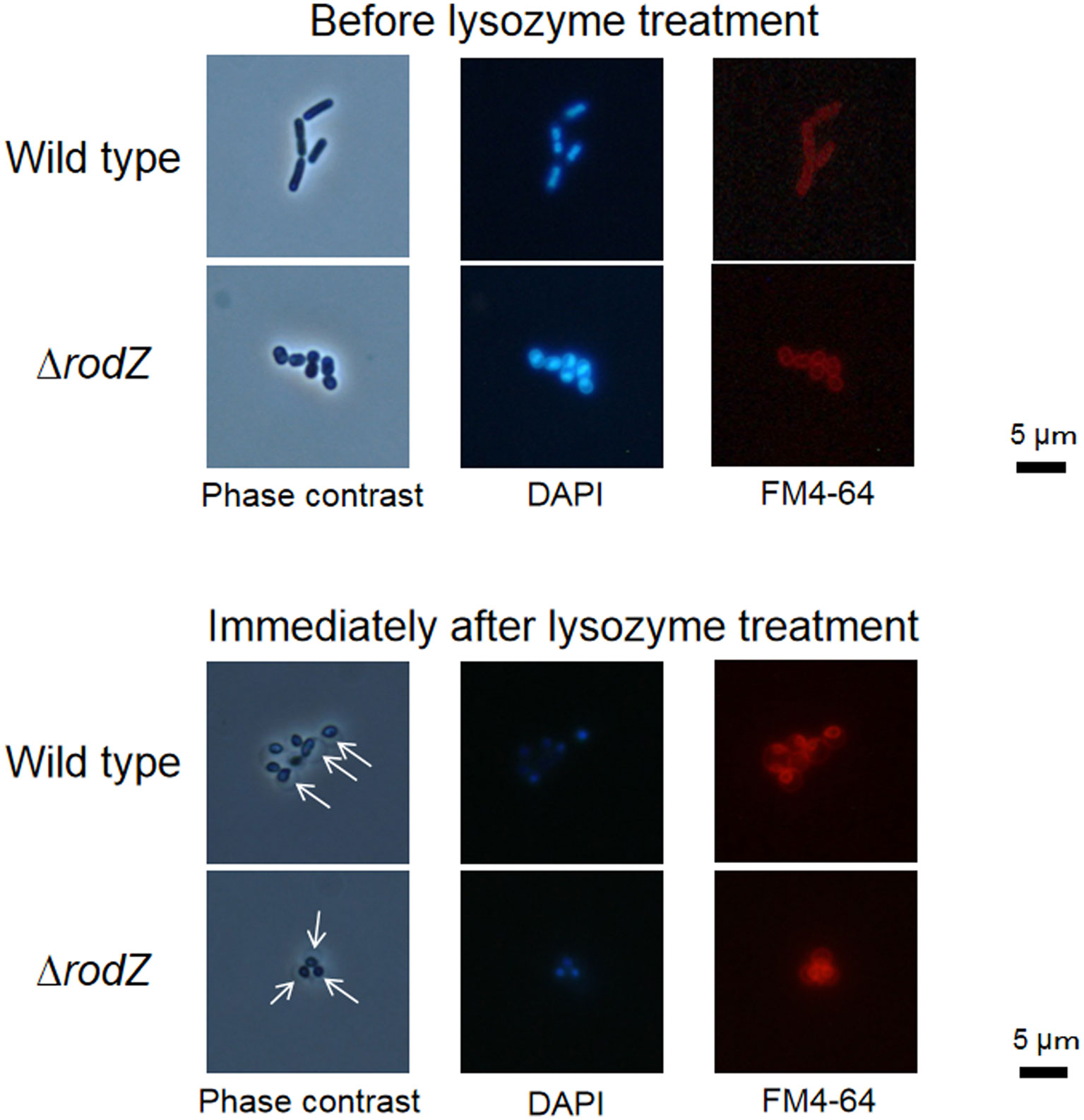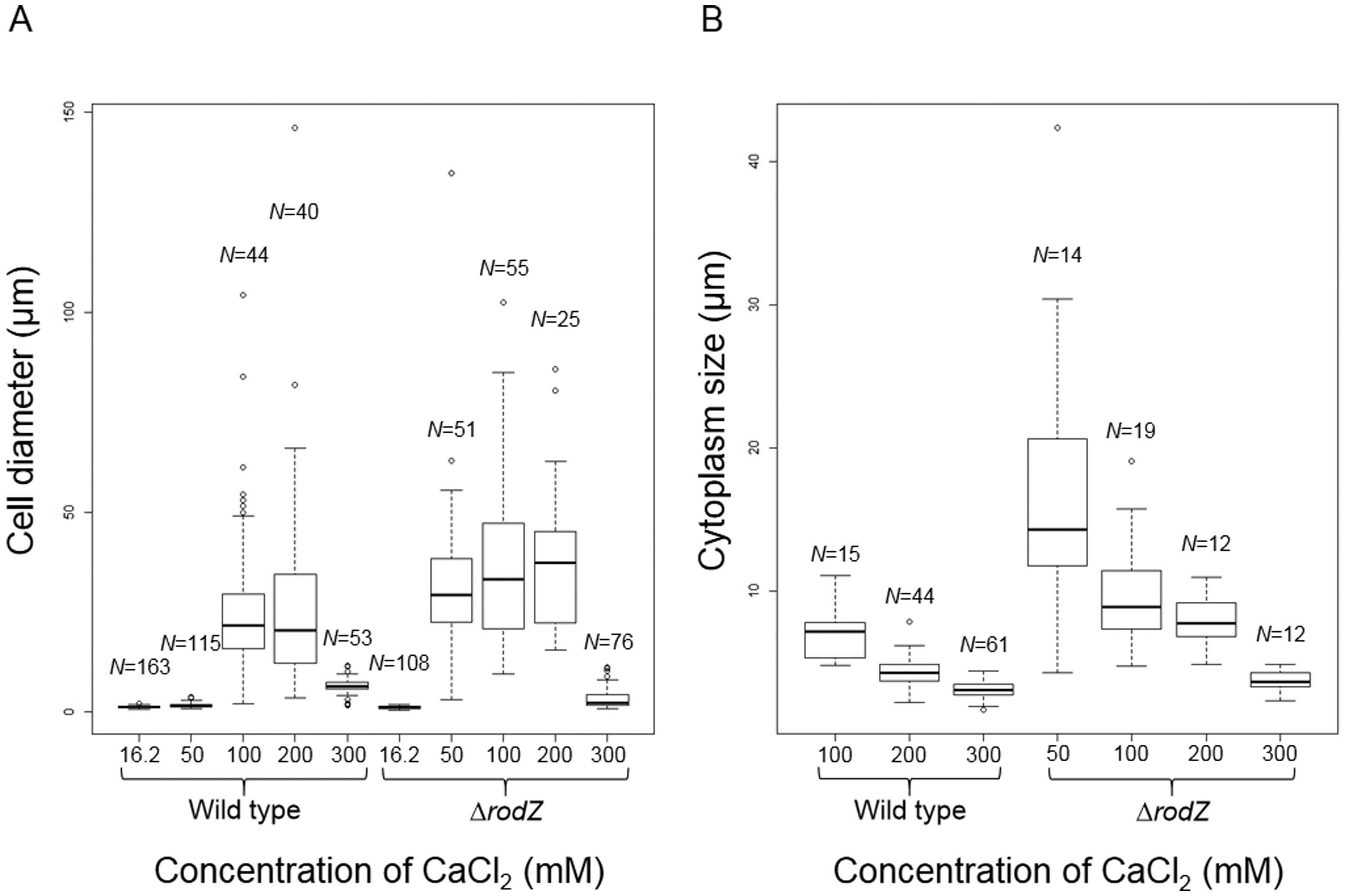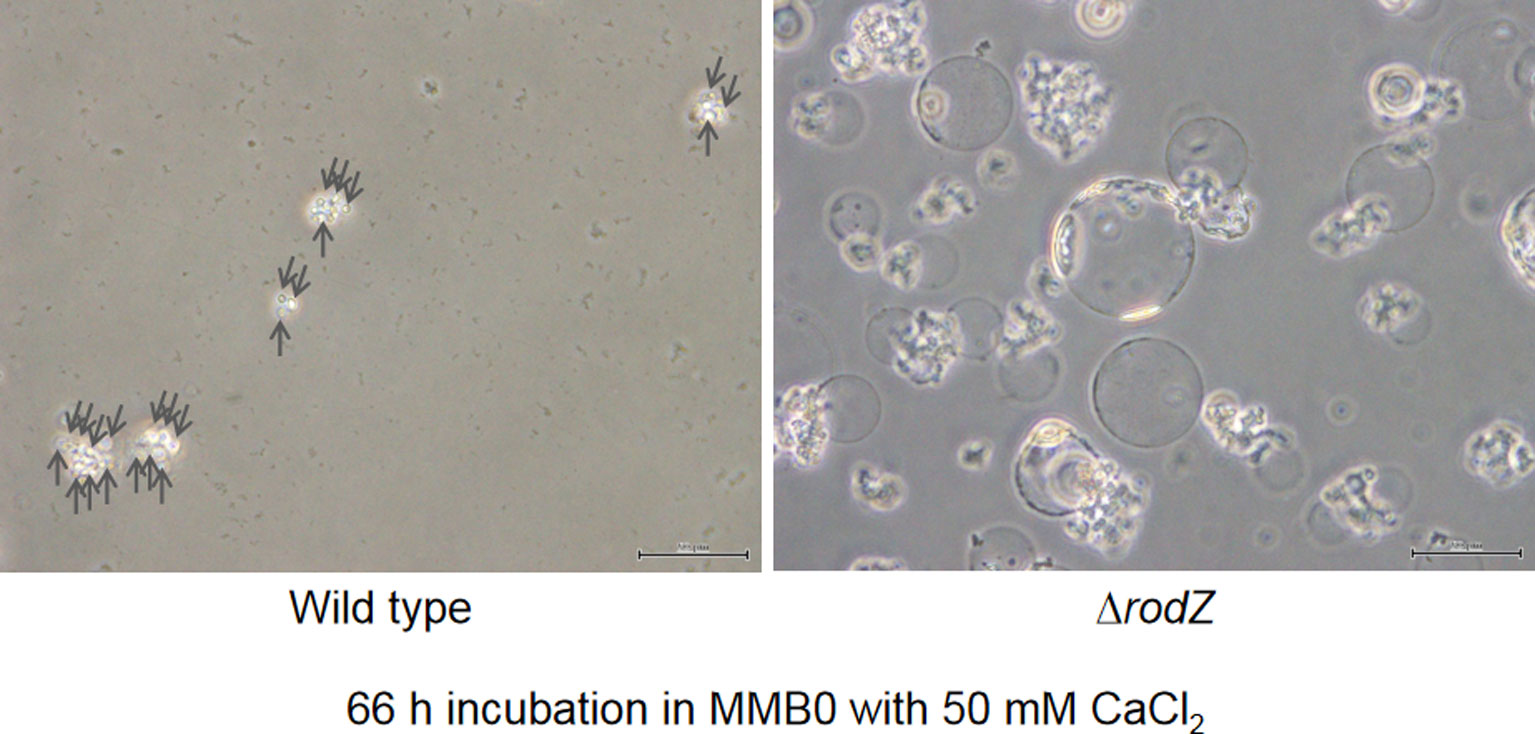RodZ is a cytoskeletal protein associated with bacterial cell shape. It is a transmembrane protein located on the plasma membrane, and it binds to another cytoskeletal protein MreB. Deinococcus grandis contains a rodZ homolog. Although D. grandis is rod-shaped, it becomes spherical in shape when the rodZ homolog is disrupted. The rodZ deletion mutant was treated with lysozyme to generate spheroplasts. The spheroplasts enlarged in medium containing calcium chloride and penicillin. The rodZ deletion mutant spheroplasts were more sensitive to calcium ions than wild type. Cell and cytoplasm sizes of enlarged spheroplasts of the rodZ deletion mutant tended to be larger than those of wild type. Thus, disruption of rodZ enhances plasma and outer membrane expansion in D. grandis spheroplasts.
1.
Introduction
The genus Deinococcus consists of both bacilli and cocci species [1]. Deinococcus lacks lipopolysaccharides on its outer membrane [2],[3]. However, the inner and outer membranes are structurally different [4],[5]. Deinococcus grandis is an aerobic Gram-negative, non-spore-forming, radioresistant, rod-shaped bacterium [6]. The spheroplasts of D. grandis enlarge in incubation medium containing penicillin under osmotically protective conditions [7]. The enlargement requires calcium or magnesium ions [7]. Outer membrane fusion occurs in the presence of calcium ions [8],[9]. Transcription or translation inhibitors prevents the spheroplast enlargement [7].
The amount and speed of outer membrane biosynthesis of D. grandis spheroplasts is higher than those of the plasma membrane [7]. Thus, enlarged spheroplasts have a large periplasmic space. Lipidomics of total cells showed that D. grandis has a unique lipid composition, as D. grandis lacks phosphatidylethanolamine (PE) and phosphatidylglycerol (PG), which are commonly found in other bacteria [7]. This is consistent with the fact that Deinococcus radiodurans has glycolipids and glycophospholipids but lacks PE and PG due to the lack of biosynthetic genes [10]–[12]. Lipid composition changes during enlargement of D. grandis spheroplasts [7]. This suggests that regulation of biosynthesis of the outer and plasma membranes may change during enlargement. Outer membrane components are synthesized in the cytoplasm or the inner leaflet of the plasma membrane. Following synthesis, these components are transported across the plasma membrane and through the periplasm to the outer membrane for assembly [13]. Thus, the transport system on the plasma membrane influences outer membrane biosynthesis.
RodZ is a bacterial protein associated with rod shape. The N-terminal region of RodZ is located in the cytoplasm, while the C-terminal region is located in the periplasm [14],[15]. The rodZ deletion mutant of Escherichia coli is not rod-shaped but round or oval [14],[15]. Homologs of rodZ are present in a wide range of bacteria [16]. RodZ binds to MreB, which is required for cell shape maintenance in rod-shaped bacteria [17]. MreB functions as the bacterial actin cytoskeleton [18],[19]. Thus, rodZ deletion mutants inhibit rod-shape formation by preventing the binding of MreB to RodZ.
D. grandis contains homologs of MreB (WP_058976727) and RodZ (WP_058975389) [1]. Lysozyme-induced enlarged spheroplasts have a large periplasmic space. Thus, plasma membrane expansion is limited. In the current study, in order to elucidate whether the MreB-RodZ cytoskeleton system inhibits plasma membrane expansion, we disrupted the rodZ homolog in D. grandis. The rodZ deletion mutant (ΔrodZ) was treated with lysozyme to induce spheroplast enlargement. We compared enlargement levels and morphology of ΔrodZ with those of the wild type.
2.
Methods
2.1. Preparation and cultivation of spheroplasts
A single colony of D. grandis KS 0485 (ATCC 43672) was streaked onto a tryptone glucose yeast extract (TGY) agar plate (5 g/L tryptone [BD, Franklin Lakes, NJ], 1 g/L glucose, 3 g/L yeast extract [BD] and 15 g/L Bacto agar [BD]) and incubated for 2 to 3 d at 30 °C. A single colony was inoculated for primary culture followed by secondary culture in 10 ml of TGY broth. The colony was incubated at 30 °C with shaking, until It reached OD600 of 0.7. Cells (6 ml) were harvested via centrifugation at 7,000 rpm (6,684 × g) for 5 min. The supernatant was discarded, and the cells were washed once with 6 mL of PS buffer (4.56 g/L KH2PO4, 4.73 g/L Na2HPO4, 171 g/L sucrose, pH 7.0) and resuspended in fresh PS buffer. The suspension was incubated with egg white lysozyme (FUJIFILM Wako Pure Chemical, Osaka, Japan) dissolved in PS buffer with 2 mM disodium EDTA (Dojindo, Kumamoto, Japan), at a final concentration of 2 mg/ml. The mixture was incubated at 37 °C for 6 h while shaking gently.
Spheroplasts were centrifuged at 8,000 rpm (4,900 g) for 5 min and resuspended in either MMB0 (5 g/L peptone, 1 g/L yeast extract, 0.1 g/L ferric citrate [Sigma-Aldrich, St. Louis, MO, USA]) containing 300 µg/ml penicillin G [Serva, München] or MMB0 containing penicillin G with different concentrations of CaCl2 [7]. Penicillin G was added to inhibit regeneration of cell walls in spheroplasts.
2.2. Disruption of rodZ homolog in D. grandis
Gene disruption targeting D. grandis rodZ was performed using a method that was originally developed to generate deletion mutants in Deinococcus radiodurans [20], with modifications. A 769-bp DNA fragment upstream of the rodZ promoter region and a 770-bp DNA fragment downstream of the rodZ open reading frame were amplified via PCR using D. grandis genomic DNA and oligonucleotide primer sets (Table 1). For PCR reaction, Tks Gflex DNA polymerase (Takara Bio, Shiga, Japan) was used. A 1,289-bp DNA fragment (KatHPH cassette) containing the D. radiodurans katA promoter and the E. coli hygromycin-resistance gene (hph) from pKatHPH4 [21] was also amplified by PCR using the oligonucleotide primer set pKat-FP and pKatRP (Table 1). The 3 DNA fragments were digested with 4 kinds of FastDigest restriction enzymes (KpnI, HindIII, BamHI, and SalI) in FastDigest Buffer (Thermo Fisher Scientific, Waltham, MA, USA), and ligated to the KpnI-SalI sites of the pUC19 vector (Takara Bio) to yield a plasmid, pAYA1, carrying the ΔrodZ::hph mutation. A 2,752-bp DNA fragment containing the ΔrodZ::hph mutation was amplified from pAYA1 via PCR using the pKat-FP/pKatRP oligonucleotide primer set and introduced into the D. grandis wild-type genome.
Transformation of D. grandis was performed as follows. D. grandis cells (1 ml) cultured at 30 °C for 24 h were washed with 1 ml of TGY broth and resuspended in 0.1 ml of TGY broth. The cell suspension was mixed with 40 µl of 0.3 M CaCl2. A 30 µl aliquot of the cell suspension was mixed with 5 µl of DNA and incubated at 30 °C. After 90 min, 2 ml of TGY broth was added to the mixture and cultured at 30 °C. Following 24 h, cells were harvested via centrifugation and resuspended in 0.4 ml of TGY broth. Aliquots of 0.1 ml were spread on TGY agar plates supplemented with 50 µg/ml hygromycin B (FUJIFILM Wako Pure Chemical) and incubated for 2 to 3 d until colonies of transformants appeared on the plate. A single colony was diluted and spread again on TGY agar plate supplemented with 50 µg/ml hygromycin B for pure culture. The resultant strain was designated ΔrodZ.
The D. grandis genomic DNA was isolated using a FastDNA Spin Kit with a FastPrep-24 Instrument (MP Biomedicals, Santa Ana, CA, USA). Gene disruption was confirmed by amplifying the target allele by genomic PCR using the oligonucleotide primer set HpH-FP and HpH-RP (Table 1).
2.3. Complementation test
To perform complementation studies, the shuttle vector pZT29 between E. coli and D. grandis was used [22]. It has a replication initiator gene, rep, from the small latent plasmid pUE30 from Deinococcus radiopugnans and a chloramphenicol resistance gene, cat, from E. coli under the control of the catalase gene promoter kat-p from D. radiodurans. A 1,245-bp DNA fragment containing the rodZ open reading frame and its promoter region of D. grandis was amplified by PCR using the genomic DNA of D. grandis and an oligonucleotide primer set (Table 1). Tks Gflex DNA polymerase (Takara Bio) was used for PCR reaction. The DNA fragment and pZT29 were digested with two restriction enzymes (EcoRV, XhoI [Roche,Diagnostics, Indianapolis, USA]) and ligated into the EcoRV-XhoI site of pZT29 vector. The plasmid pZT-rodZ was generated to express rodZ. Then, it was introduced into D. grandis ΔrodZ :: hph mutant.
Transformation of D. grandis ΔrodZ was performed as follows. D. grandis ΔrodZ cells (1 ml) cultured at 30 °C for 24 h were washed with 1 ml of TGY broth and resuspended in 0.1 ml of TGY broth. The cell suspension was mixed with 40 µl of 0.3 M CaCl2. A 30 µl aliquot of the cell suspension was mixed with 0.5 ng of plasmid pZT-rodZ and cultured at 25 °C. After 24 h, 2 ml of TGY broth was added to the mixture and cultured at 25 °C. Following 24 h, cells were harvested via centrifugation and resuspended in 0.2 ml of TGY broth. Aliquots of 0.1 ml were spread on TGY agar plates supplemented with 3 µg/ml chloramphenicol (Nacalai,Tesque, Kyoto, Japan) and incubated for 2 days until colonies of transformants appeared on the plate. The resultant strain was designated ΔrodZ pZT-rodZ.
2.4. DAPI staining
To acquire fluorescence microscopy images of nucleoids in enlarged D. grandis cells, cell suspension was mixed with 4′,6-diamidino-2-phenylindole (DAPI) (Dojindo) solution to produce a final concentration of 0.5 µg/ml and incubated at 24 °C for 1 h. Bright field, phase contrast, and fluorescence microscopy images were captured using a Keyence BZ-X710 microscope (Osaka, Japan).
2.5. Magnesium ion staining
To determine cytoplasm, we stained cytoplasmic Mg2+ in D. grandis spheroplasts. Cell suspensions were mixed with Magnesium Green, AM cell permeant (Thermo Fisher Scientific) to final concentration of 2 µM, and then incubated in each medium at 24 °C for 10 min. The membrane permeability of this Mg2+ indicator dye is enhanced by its acetoxymethyl (AM) ester. After the indicator dye crosses the plasma membrane, non-specific cytoplasmic esterase cleaves the AM ester. Following cleavage, the indicator dye can then bind to Mg2+. Phase contrast and fluorescence microscopy images were captured using an Olympus BX51 microscope.
2.6. Membrane staining
To acquire fluorescence microscopy images of the membrane in D. grandis spheroplasts, the spheroplasts were mixed with FM4-64 (Thermo Fisher Scientific) and DAPI at final concentrations of 5.0 and 0.5 µM, respectively, and incubated for 10 min at room temperature. Phase contrast and fluorescence microscopy images were captured using an Olympus BX51 microscope (Tokyo, Japan).
2.7.
Cell size measurement
Phase contrast microscopy images of spheroplasts were obtained using an Olympus CK X41 (Tokyo, Japan) or a Keyence BZ-X710 microscope. Cell diameters were measured using CellSens Standard imaging software, version 1.11 (Olympus).
3.
Results and discussion
We replaced rodZ with hph using homologous recombination. As hph contains a PstI site and rodZ does not, we confirmed the complete replacement of rodZ by cleaving the PCR product with PstI (Figure S1). Microscopic observation showed that ΔrodZ cells were spherical in shape (Figure 1). This result is consistent with the cell shape of rodZ-deletion mutants of E. coli [14],[15]. Thus, the rod shape of D. grandis may also be maintained by the MreB-RodZ system. Although the growth of ΔrodZ was slightly slower than that of wild type (Figure S2), cell division in ΔrodZ was equal to that of wild type.
The morphology of wild type and ΔrodZ spheroplasts immediately following lysozyme treatment were similar (Figure 1). DAPI staining was performed to identify cytoplasm, while FM4-64 staining was performed to identify the membrane. The spheroplasts of both wild type and ΔrodZ had a large periplasmic space, while the outer membrane was dissociated from the plasma membrane (Figures 1 and S3).
Spheroplasts were incubated in MMB0 medium [7] containing penicillin G and different concentration of calcium chloride to generate enlarged cells. The results indicated that ΔrodZ were enlarged in 50 mM calcium chloride, whereas wild type was not (Figures 2a, 3 and S4). In addition, although the growth of ΔrodZ was slightly slower than that of wild type in the cells with cell walls (Figure S2), cell size of ΔrodZ tended to be larger than that of the wild type (Figure 2a; Table S1). This result demonstrated that the ΔrodZ spheroplasts displayed a higher sensitivity to calcium ions and enlarged more than the wild-type spheroplasts. The fact that spheroplast enlargement of D. grandis required calcium ions [7], implies that the spheroplasts with higher sensitivity to calcium ions tend to enlarge. The biosynthetic speed of the outer membrane formation was higher than that of the plasma membrane during ΔrodZ enlargement (Figures 2 and S4). This suggests that rodZ disruption may enhance outer membrane expansion in D. grandis spheroplasts. Phenotype of ΔrodZ spheroplasts containing pZT-rodZ was similar to that of wild type (Figure S5). Thus, ΔrodZ pZT-rodZ was enlarged in 100 mM calcium chloride, whereas 50 mM calcium chloride was not (Figure S5).
The size of outer membrane can be measured, but the size of the cytoplasm cannot be measured in D. grandis spheroplasts. This is because a part of the cytoplasm is attached to the outer membrane [7]–[9]. Therefore, in this study, we measured the length between the edges of cytoplasmic areas attached to the outer membrane (Figure S6). It is uncertain whether the area of cytoplasm attached to the outer membrane reflects the size of cytoplasm. However, the size between both edges of the cytoplasm reflects a morphological change in the cytoplasm. The cytoplasm size of ΔrodZ was significantly higher (p < 0.05) than that of the wild type at 200 mM CaCl2 (Figure 2b, Table S2), suggesting that rodZ disruption enhanced plasma membrane expansion in D. grandis spheroplasts. However, the size measured in this study did not have a corresponding peak at 100 to 200 mM in ΔrodZ spheroplasts (Figure 2b), which differed from the enlarged pattern of the outer membrane expansion. As the concentration of CaCl2 increased, the cytoplasm size tended to decrease in the spheroplasts of both wild type and ΔrodZ (Figure 2b). In terms of cell sizes between in 100 mM and 200 mM of CaCl2 (Figure 2a), they were not significantly different in both the wild type and ΔrodZ (p > 0.05, Table S1). On the other hand, when compared cytoplasm sizes between in 100 mM and 200 mM of CaCl2 (Figure 2b), they were not significantly different in ΔrodZ but they were significantly different (p < 0.05) in the wild type (Table S2). The cytoplasm size significantly decreased in wild type but it did not in ΔrodZ. Thus, rodZ disruption affects plasma membrane expansion in D. grandis spheroplasts.
High concentration (300 mM) of CaCl2 inhibited the enlargement (Figure 2), which is consistent with the previous studies [7],[8].
RodZ is located on the plasma membrane. Therefore, it may be expected that ΔrodZ tends to have a larger plasma membrane during spheroplast enlargement than that of the wild type. However, the reason why ΔrodZ tends to have a larger outer membrane remains unclear.
Considering that outer membrane components are transported across the plasma membrane and through the periplasm to assemble in the outer membrane [13], removal of RodZ from the plasma membrane may affect the transport of outer membrane components.









 DownLoad:
DownLoad:








